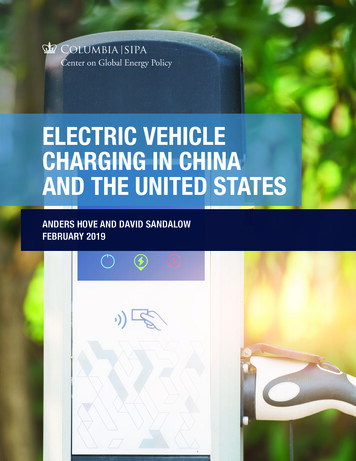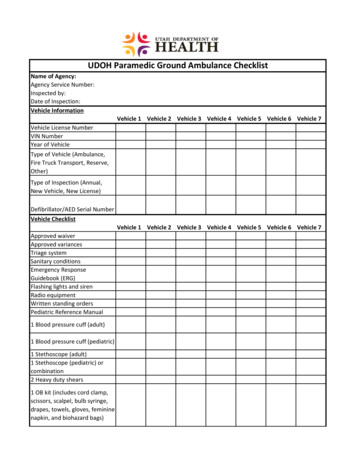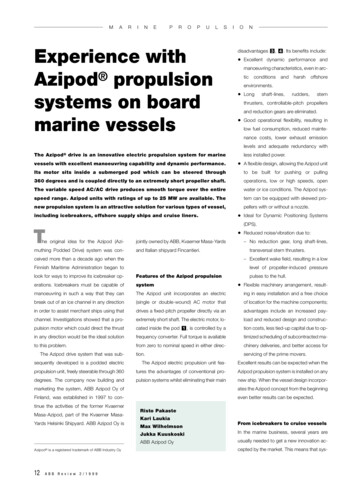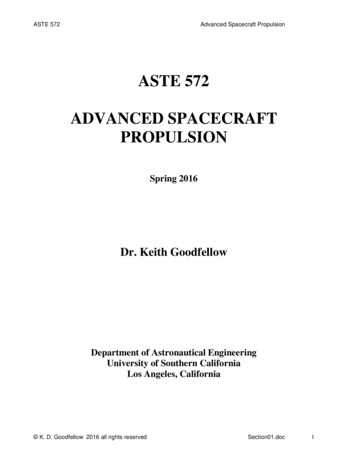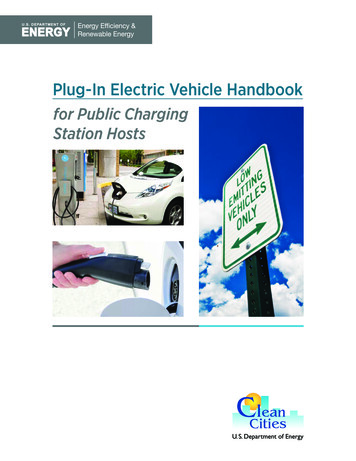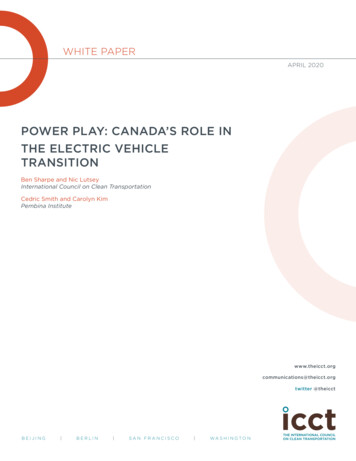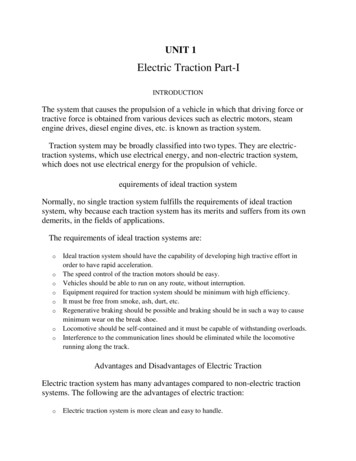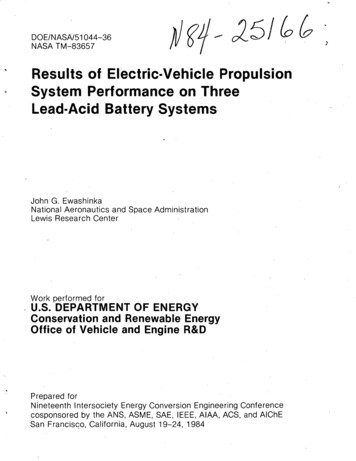
Transcription
DOE/NASA/51044-36NASA TM-83657Results of Electric-Vehicle PropulsionSystem Performance on ThreeLead-Acid Battery SystemsJohn G. EwashinkaNational Aeronautics and Space AdministrationLewis Research CenterWork performed forU.S. DEPARTMENT OF ENERGYConservation and Renewable EnergyOffice of Vehicle and Engine R&DPrepared forNineteenth Intersociety Energy Conversion Engineering Conferencecosponsored by the ANS, ASME, SAE, IEEE, AIAA, ACS, and AlChESan Francisco, California, August 19-24, 1984
DISCLAIMERThis report was prepared as an account of work sponsored by an agencyof the United States Government. Neither the United States Governmentnor any agency thereof, nor any of their employees, makes any warranty,express or implied, or assumes any legal liability or responsibility for theaccuracy, completeness, or usefulness of any information, apparatus,product, or process disclosed, or represents that its use would notinfringe privately owned rights. Reference herein to any specificcommercial product, process, or service by trade name, trademark,manufacturer, or otherwise, does not necessarily constitute or imply itsendorsement, recommendation, or favoring by the United StatesGovernment or any agency thereof. The views and opinions of authorsexpressed herein do not necessarily state or reflect those of the UnitedStates Government or any agency thereof.Printed in the United States of AmericaAvailable fromNational Technical Information ServiceU.S. Department of Commerce5285 Port Royal RoadSpringfield, VA 22161NTIS price codes1Printed copy: A02Microfiche copy: A011Codes are used for pricing all publications. The code is determined bythe number of pages in the publication. Information pertaining to thepricing codes can be found in the current issues of the followingpublications, which are generally available in most libraries: EnergyResearch Abstracts (ERA); Government Reports Announcements and Index(GRA and I): Scientific and Technical Abstract Reports (STAR); andpublication, NTIS-PR-360 available from NTIS at the above address.
\DOE/NASA/51044-36NASA TM-83657Results of Electric-Vehicle PropulsionSystem Performance on ThreeLead-Acid Battery SystemsJohn G. EwashinkaNational Aeronautics and Space AdministrationLewis Research CenterCleveland, Ohio 44135Work performed forU.S. DEPARTMENT OF ENERGYConservation and Renewable EnergyOffice of Vehicle and Engine R&DWashington, D.C. 20545Under Interagency Agreement DE-AI01-77CS51044Prepared forNineteenth Intersociety Energy Conversion Engineering Conferencecosponsored by the ANS, ASME, SAE, IEEE, AIAA, ACS, and AlChESan Francisco, California, August 19-24, 1984
RESULTS OF ELECTRIC-VEHICLE PROPULSION SYSTEM PERFORMANCE ONTHREE LEAD-ACID BATTERY SYSTEMSby John G. EwashinkaNational Aeronautics and Space AdministrationLewis Research CenterCleveland, Ohio 44135SUMMARYThree types of nominal 6-V lead-acidbatteries, one in current use and the othertwo proposed as near-term candidates for useby the electric vehicle industry, were tested fZ at the Naval Weapons Support Center, Crane,S Indiana, under laboratory conditions. Theti primary objective of this work was to determine the cycle life of lead-acid batteriesas a function of electric vehicle propulsionsystem design. Included in this objectivewas a comparison of different battery types(EV106 baseline versus state-of-the art3KQ-11 tubular and EV1000 thin plate batteries) as pertaining to cycle life, degradation rate, and respective failure modes. Inaddition, the secondary test objectives wereto study the effects of testing in threeversus six series strings in relation tooverall performance.The test profiles chosen are defined inthe SAE 0227a, schedule D specification for ahypothetical vehicle with the following characteristics: weight, 1701 kg (3750 Ib);product of aerodynamic drag ; and tire coefficient, l.lxlOy2.The electric vehicle battery pack is a 120-Vsystem consisting of twenty 6-V lead-acidmodules. The propulsion system was assumedto have 70 percent efficiency during acceleration and 50 percent efficiency duringregenerative deceleration.INTRODUCTIONBatteries in today's electric vehiclesrepresent a small fraction of the initialcost of an electric vehicle. In the nearterm, as electric vehicle technology improvesand markets develop and new types of batteries are made available, the batteriesw i l l constitute a higher, but still small,percentage of the initial cost. However,the driving costs (dollars/mi) are significantly impacted by the cycle life of thebattery. Electric vehicle propulsion systemdesigns, in the past, have concentrated onmaximizing the capabilities of batteries ona per discharge basis but only minimal consideration was given to the design's impacton battery cycle life.Buffered propulsion systems such asthose with flywheels, offer increased acceleration and a possible increased range.Electrical regeneration propulsion systemsmay also offer extended range. The worthiness of these two systems will not only bebased on their ability to extend the range ofan electric vehicle, but also their effectson the cycle life costs of batteries(dollars/mi). The Government cannot affordto support and develop both system approaches. Therefore, we must narrow thealternatives by evaluating the effects thesevarious systems have on the cycle life ofbatteries. Three generic types of propulsionsystems have been chosen to evaluate theireffect on battery cycle life and are as follows: (1) The baseline which has no bufferand no electrical regeneration, (2) The buffered system which tends to load level thebattery and, (3) The electrically regenerative system.Three types of lead-acid batteries werechosen for testing. One was a standard offthe-shelf golf car battery (EV106) used as abaseline. The remaining two batteries wereimproved types expected to be available inthe near-term. One of the two was a tubularplate battery, model 3KQ-11, manufactured byEagle-Picher, specifically designed for loadleveled discharge. The other battery was aflat plate, Globe Union, model EV1000,designed for a nonleveled electrical regenerative system.Thirty batteries were procured from eachmanufacturer. Each group of batteries underwent formation cycling at each manufacturer'srecommended rates to verify battery capacityratings. Once completed, 27 batteries wereselected from each manufacturer for distribution on three constant power discharge profiles designed to simulate nonregenerative,electrical regenerative, and mechanicalregenerative (load-leveled) propulsionsystems. The nonregenerative discharge profile was considered to be the baseline systemagainst which comparisons would be made toevaluate the performance of the regenerativeand load-leveled propulsion systems. Thefollowing are some of the questions that areaddressed and discussed in this paper: Arethe benefits of electrical regeneration (increased vehicle range) offset by a decreasein cycle life? Is the increased complexity
of a mechanical regenerative (load-leveled)system justified in terms of cycle life orrange over an electrical regeneration systems?Which propulsion system optimizes batterycycle life and performance? And finally,will the state-of-the-art developments inlead-acid batteries significantly improvethe performance of electric vehicles?DETERMINATION OF TESTING PARAMETERSPower-Time ProfilesThe three power-time profiles designedto simulate nonregenerative, electrical regenerative, and mechanical regenerative(load-leveled) propulsion systems werederived from the SAE J227a Schedule D drivingcycle (1). Each profile was 122 seconds induration, with power levels based on eitherthree-battery or six-battery series strings.Table I contains the power levels corresponding to time for each propulsion system. Thepower-time profiles are shown graphically inFig. 1.actual performance. The "normalized capacityprocedure" is as follows:Following formation, three batterieswere selected from each manufacturer thatwere representative of the group as a wholein amp-hr output. Each battery was discharged three times at the manufacturer'sdischarge rate to 5.25 volts per battery.The average capacity of the three batterieswas called the "prevailing capacity" of thebattery. Each battery was then dischargedthree times on the SAEJ227a Schedule Ddriving cycle (nonregenerative) to 3.9 voltsper battery. The averaged results of thesedischarges was called the "average observedcapacity." From this data, the normalizedcapacity rating of each battery type wasdetermined from the following formula.Manufacturer Rated CapacityNormalized CapacityPrevai1 ing Capacityx Average observedcapacityLIFE CYCLE TESTSCycle DefinitionA discharge cycle was defined as a continuous repetition of discharge profiles (asdefined above) to a predetermined depth ofdischarge or to a cut off voltage. On theregenerative profile, amp-hrs returned duringthe charge portion of the profile were subtracted from amp-hrs removed during dischargeto determine the net amp-hr output. Thisnet value was used to determine depth ofdischarge. A charge cycle was defined asthe charge recommended by the manufacturerwhich brought the battery to the 100 percentstate of charge. The combination of a discharge cycle and a charge cycle constitutedone complete cycle.Twenty-seven batteries from each manufacturer were selected for life cycle testsbased on uniformity in amp-hr output duringformation cycling. These batteries were randomly distributed on the three propulsionsystem tests as follows:NonregenerativeRegenerativeLoad-LeveledOne 3-battery string One 3-battery string One 3-battery stringOne 6-battcry string One 6-battery string One 6-battery stringLife cycle testing was conducted on eachbattery string according to the followingprocedure. Battery strings were discharged onthe applicable power profile to a depth-ofdischarge of 80 percent of normalized capacityor to an average string voltage of 3.9 volts/battery, whichever occurred first.Normalized Capacity DeterminationAs part of the test design, dischargecycles were to be conducted to a depth ofdischarge of 80 percent of rated capacity.Because the capacity of lead-acid batteriesvaries with changes in the discharge rate,the amp-hr ratings of these batteries (asdetermined by their respective manufacturers)were not applicable to the power profiledischarges designed for this test.A procedure for determining an appropriate capacity rating for each battery wasagreed upon by the three battery manufacturers. This procedure uses the baseline(nonregenerative) discharge profile toestablish capacity and in effect normalizetest results between battery design andCharging of each battery string was conducted according to the manufacturer's recommended charge procedure (this will bediscussed later in this paper). This cyclingsequence (charge/discharge) was repeated atthe rate of one cycle per day until batteryfailure(s) occurred. Every 50iQ cycle acapacity check (on the applicable power profile) was made on each battery to an averagebattery cut off voltage of 3.9 volts. Failureof a battery was defined as two successivecycles where a battery in a string reached thecut off voltage of 3.9 volts before 80 percentof the normalized capacity was removed. Thefailed battery was removed from the respectivestring and cycling was continued on the remaining batteries. The last battery remainingin each string was cycled until battery
capacity removed dropped to 40 percent of thenormalized capacity.to service the batteries, and the amount usedfor each cell was recorded.Charge ProceduresEnvironmental ControlsThe charge procedures used for each battery type were those recommended by the manufacturer. All charges were the constantpotential type to a fixed percentage recharge.These procedures are outlined below for eachbattery type:The test laboratory for this program wastemperature controlled at 24 C (75 F) yearround. Charge and discharge cycles were notstarted unless the electrolyte temperature ofeach battery in a string was within 5 C(9 F) of room temperature.Exide EV106 baseline: Using a startingcurrent of 30 amperes, each battery string wascharged until the average battery voltagereached 7.80 volts per battery. This voltagewas maintained until 120 percent of the amphrs removed on discharge were returned.Equalization Charge - Twice every month, thenormal charge procedure identified above wasextended to include a constant current chargeat 6 amperes for 10 hours to equalize thebatteries.Globe Union EV1000 thin flat platepositive: The starting current for eachcharge cycle was again 30 amperes. Each battery string was charged until the averagebattery voltage reached a temperature corrected voltage determined by the equation1/B 8.96 - 0.012T (where T batteryelectrolyte temperature in degrees F). Thisvoltage was maintained until the charge current dropped to 5.5 amperes. At this timethe charge was returned to the constant current mode and the battery string was chargedat 5.5 amperes until 120 percent of the amphrs removed on discharge were returned.Equalization Charge - Every seven cycles, theconstant current portion of the above procedure (at 5.5 amperes) was extended until 140percent of the amp-hrs removed on dischargewere returned.Eagle-Richer 3KQ-11 tubular positive:The starting current for each charge cycle onthe 3KQ-11 batteries was 25 amperes. Eachbattery string was charged until the averagebattery voltage reached 7.50 volts. Thisvalue was maintained until 115 percent of theamp-hrs removed on discharge were returned.Equalization Charge - Once every month, following the completion of the normal chargeprocedure identified above, each batterystring was charged at 5 amperes constant current for 12 hours to equalize the batteries.Maintenance ScheduleOne each week,cycle, each batterychecked for loss ofmade if necessary.at the end of a chargestring was visuallywater and additions wereDistilled water was usedDESCRIPTION OF FACILITYThe propulsion cycling facility at theNaval Weapons Support Center, Crane, Indiana,was designed to discharge battery strings upto 50 volts under any power-time profile. Thetest facility utilized a Hewlett-Packard ModelHP-35 desktop computer with data acquisitionand control expansion units to monitor andcontrol 18 test stations, one for each batterystring tested. Because of system demandsduring a discharge cycle, only one batterystring could be discharged at any one time.To control the power-time profiles duringdischarge, the computer was programmed to readbattery string voltage once each second andadjust the current level to maintain the constant power requirement. Three electronicloads were used for current control duringdischarge. Two 150 amp dc power supplies connected in parallel were used for the regeneration period of the profile. Eighteen dc powersupplies were used for charging, one for eachbattery string.Data AcquisitionThe data acquisition for the Crane facility was fully automated with the exception ofspecific gravity and electrolyte temperaturemeasurements, which were done manually.Important end point measurements of the acceleration, cruise, coast, and deceleration (regenerative) were taken and stored on magnetictape for future analysis of the data. Alsostored on magnetic tape was the accumulatedamp-hrs and watt-hours for each profile andstring.TEST RESULTS AND DISCUSSIONEffects of ProfileThe effects of the three profiles (nonregenerative, regenerative, and load-leveled)on capacity and cycle life of the three battery types were determined by observing thecapacity loss and failure rates during thelife cycle testing.
It should be noted that the differencesin power levels between profiles would accountfor the variations in battery capacity. Usingdata from actual cycles performed on the batteries, the average current of the nonregenerative and regenerative profiles was approximately 110 amps. Whereas for the load-leveledprofile, the average current was approximately65 amps. The well-known relationship betweenamp-hr capacity and discharge rate of a leadacid battery explains why such differencescould be expected (2).Figures 2 and 3 show the results of lifecycling on three and six battery strings forthe baseline EV106 battery (normalizedcapacity 112 amp-hrs). Capacity in amp-hrs isplotted against discharge cycles for each ofthe three profiles, which individual batterycycle failures are identified. From the datapresented in Figs. 2 and 3, it is apparentthat significant differences in capacity existbetween the load-leveled and the nonregenerative and regenerative cases. Variations incapacity between the nonregenerative andregenerative cases are of relatively smallmagnitude, which indicates the cycle life doesnot appear to be significantly affected by thetype of profile used, although failures of theload-leveled case did lag (slightly) those ofthe nonregenerative and regenerative cases.Table II summarizes the average cycle life ofthe baseline batteries for each profile bothfor three and six battery strings.Figures 4 and 5 shows the amp-hr capacityversus cycle life for the EV1000 batteries andTable IV is the summary of the average cyclelife for the EV1000 batteries. The conclusions arrived are the same as those withthe baseline EV106 batteries. Differences incapacity and cycle life for the nonregenerative and regenerative cases, although significant for the three battery string, cannotbe explained for the six battery strings.Life cycling results of the tubularpositive 3KQ-11 battery are shown in Figs. 6and 7. Batteries for the load-leveled casecompleted an excess of 200 cycles with nofailures. As noted in Fig. 6, all three batteries on the nonregenerative and regenerativecases failed early in the cycling tests andtesting was discontinued at the point wherecapacity fell below 80 percent of normalizedcapacity. Although a cluster of batteryfailures occurred early for the nonregenerative and regenerative case (six batterystring) a decision was made to continuecycling the remaining battery until failureat the 40 percent of normalized capacity.This battery maintained capacity in excess of80 percent of normalized for over 200 cyclesat which point testing was discontinued.Table IV shows the results of the averagecycle life for each discharge profile.Clearly, for a load-leveled application thetubular positive designed battery is vastlysuperior.Comparison of Battery Types on Each DischargeProfileNonregenerative Profile: The performanceof the three battery types on the nonregenerative profile was poor. Within 150 cycles,44 percent of the EV106 baseline batteries hadfailed, 88 percent of the 3KQ-11 tubular/platebatteries had failed, and 90 percent of thethin plate EV1000 had failed. The maximumnumber of cycles completed by any battery typewas 254 cycles (although one tubular platebattery was stopped before failure at 229cycles). Capacity loss in all cases was veryrapid, especially for the thin plate andtubular plate batteries (refer to figs. 2to 7).Regenerative Profile: The performanceof each battery type on the regenerative profile differed very little from the performanceobserved on the nonregenerative profile. Asbefore, 44 percent of the baseline and 88 percent of the tubular plate batteries failedbefore completing 150 cycles. One-hundredpercent of the thin plate batteries failed .before cycle 150. Again capacity loss occurred very rapidly for the thin plate andtubular positive batteries but comparativelyslower for the baseline batteries (refer tofigs. 2 to 7).Load-Leveled Profile: The load-leveledprofile, the least demanding in terms of powerderived from the batteries, yielded the bestperformance from all three battery types.However, only in the case of the tubular platebatteries was a significant increase in performance noted. For the nine tubular platebatteries cycled on the load-leveled profilethere were no recorded failures and thecapacity was still above 90 percent oforiginal capacity after 231 cycles (Testingterminated). Only 11 percent of the baselinebatteries failed within 150 cycles, but within250 cycles, 89 percent of the baseline batteries had failed. For the thin plate batteries, 78 percent failed within 150 cycles,and no battery exceeded 200 cycles.The differences in the amp-hr ratings(normalized capacity) between battery typesresulted in a variable range (profiles completed per cycle). Table V compares dischargedata from a typical cycle for each batterytype, including number of profiles completedand discharge times to 80 percent depth-ofdischarge, and specific gravities and temperatures observed at the beginning and endof a cycle.
Performance Comparison of Three-BatteryVersus Six-Battery StringsComparisons of amp-hr output (at 50 cycleintervals) and average cycle life for threeversus six battery strings of each type battery are shown in Table VI. Only insignificant differences in capacity existed on agiven profile between three and six batterystrings throughout the life test, except ininstances where shorted cells may have limitedthe capacity of the string prematurely. Interms of cycle life, the baseline EV106 andthin plate EV1000 batteries equated veryclosely when comparing three and six batterystrings. The results for the tubular positive3KQ11 batteries were more diverse, with cyclelife for the six string from 50 to 100 percentgreater than the three battery string. Cyclelife comparison for the 3KQ11 batteries couldonly be made for the nonregenerative andregenerative profiles, since no failuresoccurred for the load-leveled profiles.Failure Modes During Life Cycle TestsFailure during life cycle tests wasattributed to a different cause for eachbattery type through autopsies. Separatorfailures, causing shorted cells and subsequent loss of capacity were identified asthe failure mode in all of the EV106 baselinebatteries. The EV1000 thin plate batteriesfailed due to loss of capacity caused byexcessive grid corrosion. The 3KQ11 tubularplate batteries showed no sign of mechanicaltype failure. Failure was simply attributedto the design limitations of the battery (batteries not designed for high current discharges such as those demanded by the nonregenerative and regenerative profiles).CONCLUSIONSThe performance of all three batterytypes for the nonregenerative and regenerativecases does not raise expectations that aneconomically feasible battery system currentlyexists for these propulsion systems. Eachpair of battery strings for all three batteries followed virtually the same failurepattern during life cycle testing. It is perhaps significant that the modes of failure foreach battery type were different, suggestingthat these profiles cause degradation not inany one design area but in all areas. Onlyfor the tubular plate batteries on the loadleveled profile were the cycle life resultsencouraging. Finally, it does not appearthat state-of-the-art developments in leadacid batteries have significantly improvedperformance over the baseline batteries. Apossible exception is the tubular platebattery for a load-leveled application.In terms of profiles completed during adischarge cycle, both electrical regenerationand mechanical regeneration (load-leveled)significantly increased the range of thevehicle driving cycle. Using average figuresfor the three battery types, electrical regeneration increased the range by 29 percent overthe driving profile with no regeneration. Forthe load-leveled profile, this increase was42.5 percent.REFERENCES"Electric Vehicle Test Procedure," SAERecommended Practice J227a, SAE Handbook,Society of Automotive Engineers, Inc.,Warrendale, PA, 1979, pp. 27.07-27.12.J. G. Ewashinka, and J. M. Bozek,"Characterization, Performance, and Prediction of a Lead-Acid Battery UnderSimulated Electric Vehicle DrivingRequirements," DOE/NASA/51044-19, NASATM-81771, 1981, p. 10.
TABLE I. - POWER-TIME s string,kWSix-batteryseries string,kWBaseline0 to 60 to 3.48 discharge36 to 283.48 discharge28 to 781.23 discharge78 to 12200 to 6.96 discharge36.96 discharge2.46 discharge0Electricalregenerative0 to 66 to 2828 to 7878 to 8888 to 970 to 3.48 discharge33.48 discharge1.23 discharge1.905 charge4.125 to 0 charge30 to 6.96 discharge36.96 discharge2.46 discharge3.81 charge8.25 to 0 charge3Loadleveled02878973to 28 0.051 to 1.485to 781.485to 97 1.485 to 0.051to 1220.051discharge3discharge 3dischargedischarge0.102 to 2.972.972.97 to 0.1020.102discharge3discharge 3dischargedischargeLinear change in power with time.TABLE II. - SUMMARY OF AVERAGE CYCLE LIFE LIFE FOR EV106BATTERIES FROM LIFE CYCLING TESTProfile typeAverage cycles completedThree-battery strings Six-battery 57209169160212aaOne battery still cycling at the time testing was discontinued.TABLE III. - SUMMARY OF AVERAGE CYCLE LIFE LIFE FOR EV1000BATTERIES FROM LIFE CYCLING TESTProfile typeAverage Cycles CompletedThree-battery strings Six-battery 8413210195132Does not include one battery damaged during testing anddiscontinued at 39 cycles.
TABLE IV. - SUMMARY OF AVERAGE CYCLE LIFE LIFE FOR 3KQ-11BATTERIES FROM LIFE CYCLING TESTProfile typeAverage cycles completedThree-battery strings Six-battery stringsNonregenerativeRegenerativeLoad-leveled 61364C233t 131b94C231 A11batteries discontinued at this point.bOnebatteryremaining at the time testing was discontinued.cNo failures at the time testing was discontinued.TABLE V. - DISCHARGE CYCLE TEST RESULTSManufacturer/battery typeExide/EV106Globe nerativeEagle-Picher/ Nonregenerative3KQ-UaTotalTemperature, C Ampere-hour capacity Specific gravity* Number ofprofiles perdischargecycleInitial FinalInitial Final Removed Regeneratedtime,minTemperature corrected.
TABLE VI. - PERFORMANCE COMPARISON OF THREE VS. SIX-BATTERY STRINGSManufacturer/battery typeDischargeprofileCycles completedprior to battery Six-batteryThree-battery eRegenerativeLoad-leveledGlobe 2N/AN/AN/AN/A107104114112N/At N/AN/A"'One battery still cycling at the time testing was discontinued."All batteries discontinued at this point.No failures at the time testing was discontinued.c209C233C231
IIIIIII(a) Nonregenerative profile (122 sec duration).oO-IIRegenerative profile (122 sec duration).I20I40I6080TIME, sec100I120(c) Load-leveled profile (122 sec duration).Figure 1. - Power time profiles. (3-Battery string) kWvalues double for 6- battery string.140
NONREGENERATIVEREGENERATIVELOAD-LEVELEDCIRCLES DENOTE INDIVIDUALBATTERY FAILURESQ5oNORMALIZED CAPACITY: 112AHII150200DISCHARGE CYCLESFigure 2. - EV106 three-battery test string, 50 cycle capacity to 3.9 IRCLES DENOTE INDIVIDUALBATTERY FAILURES14013012011010090807060NORMALIZED CAPACITY: 112AH50I4050100II150200DISCHARGE CYCLES250300Figure 3. - EV106 six-battery test string, 50 cycle capacity to 3.9 V/battery.
ES DENOTE INDIVIDUALBATTERY FAILURES EXCEPT:CYCLE 32-. 1 REGEN. FAILURECYCLE 39: 2 NON-REGEN. FAILURES140130120110Q10090NORMALIZEDCAPACITY:141 AH8070601500100150200250DISCHARGE CYCLESFigure 4. - EV1000 three-battery test string, 50 cycle capacity to 3.9 IRCLES DENOTE INDIVIDUAL BATTERY FAILURES160\150NORMALIZED CAPACITY: 141 GE CYCLESFigures. - EV 1000 six-battery test string, 50 cycle capacity to 3.90 V/battery.
140 r—— 130120110.c o.o/-NO FAILURES \* — —\" ALL BATTERIES DISCONTINUED100 &90 —NON REGENERATIVEREGENERATIVELOAD-LEVELED80 70 —60 —504050NORMALIZED CAPACITY: 125AH110011150200DISCHARGE CYCLES11250300Figure 6. - 3KQ-11 three-battery test string, 50 cycle capacity to 3.9 IRCLES DENOTE INDIVIDUALBATTERY FAILURES140130120110a.O100908050NORMALIZED CAPACITY: 125 AHI100II150200DISCHARGE CYCLES250300Figure 7. - 3KQ-11 six-battery test string, 50 cycle capacity to 3.9 V/battery.
1. Report No.3. Recipient's Catalog No2. Government Accession No.NASA TM-836574. Title and Subtitle5. Report DateResults of Electric-Vehicle Propulsion SystemPerformance on Three Lead-Acid Battery Systems6. Performing Organization Code778-36-688. Performing Organization Report No.7. Aumor(s)E-2015John G. Ewashinka10. Work Unit No.9. Performing Organization Name and AddressNational Aeronautics and Space AdministrationLewis Research CenterCleveland, Ohio 4413511. Contract or Grant No.13. Type of Report and Period Covered12. Sponsoring Agency Name and AddressTechnical MemorandumU.S. Department of EnergyOffice of Vehicle and Engine R&DWashington, D.C. 2054514. Sponsoring Agency-Cede ReportNo ,DOE/NASA/51044-36IS. Supplementary NotesPrepared under Interagency Agreement DE-AI01-77CS51044. Prepared for NineteenthIntersociety Energy Conversion Engineering Conference cosponsored by the ANS,ASME, SAE, IEEE, AIAA, ACS, and AIChE, San Franc
projected frontal area CnA, 0.84 M2 (9 ft2); and tire coefficient, l.lxlOy2. The electric vehicle battery pack is a 120-V system consisting of twenty 6-V lead-acid modules. The propulsion system was assumed to have 70 percent efficiency during acceler-ation and 50 percent efficiency during regenerative deceleration. INTRODUCTION

